Starting Amazon FBA businesses (Fulfillment by Amazon) has become an increasingly popular venture for aspiring entrepreneurs. This business model allows individuals to not only leverage the massive reach and infrastructure of Amazon but also decrease operational effort for sellers, one of the best marketplaces to sell their products online. But how to start an Amazon FBA business successfully? If you’re looking to embark on this exciting journey, you’ve come to the right place.
In this guide, we will dive in and discover how to start an Amazon FBA business step-by-step and pave the way to financial independence as follows:
- Step 1: Research and plan for Amazon FBA business
- Step 2: Select products to sell on Amazon
- Step 3: Find suppliers or manufacturers
- Step 4: Create an Amazon seller account
- Step 5: Create Amazon listings
- Step 6: Register with fulfillment by Amazon-FBA
- Step 7: Set up shipping plans and tracking inventory
- Step 8: Optimize product listing
- Step 9: Build a promotion plan
What is Amazon FBA Business?
Amazon FBA (Fulfillment by Amazon) is a program offered by Amazon that allows third-party sellers to take advantage of Amazon’s fulfillment service. FBA sellers can store their products in Amazon’s fulfillment centers, and this platform takes care of the rest – from packing and shipping to handling customer service and returns.
Here’s how does Amazon FBA work:
1. A seller lists their products on Amazon
2. The seller sends their products to the Amazon fulfillment business. Amazon stores the products in its warehouse until they are sold.
3. When a customer places an order for the product, Amazon picks, packs, and ships the item to the customer on behalf of the seller.
4. Amazon also handles customer service for orders and any returns that might be required.
Overall, though, FBA can be a great option for any business to grow their shop on the Amazon marketplace.
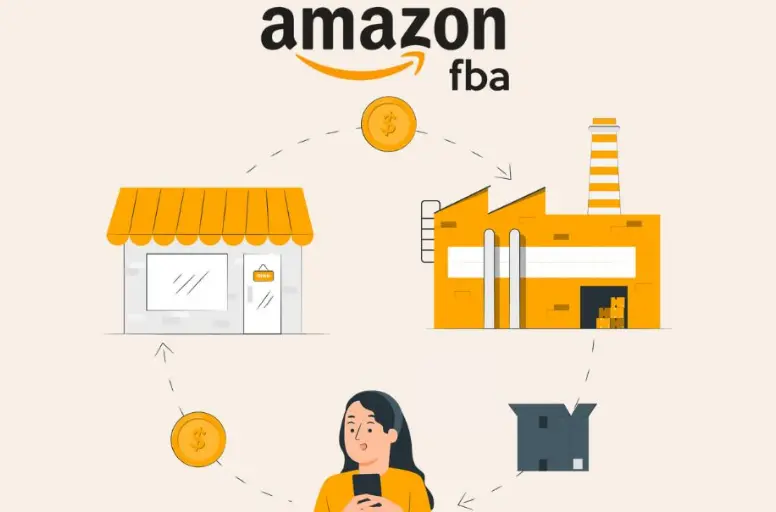
How to Start an Amazon FBA Business
FBA removes the complexities of storage, shipping, and customer service, it offers an array of benefits for sellers to eliminate the need for warehouses, inventory management, and customer services besides its large customer base.
Wanna start your seller journey but don’t know how to start an Amazon FBA business with little money? We’ll walk you through every step of launching your FBA journey to success. But first, here is an how to sell on Amazon guide for new sellers:
Step 1: Research and plan for Amazon FBA business
- Market and product analysis: When starting an Amazon store with FBA, conducting comprehensive market research and careful planning are essential initial steps. Here are some steps you can apply:
- #1. Identify your target audience: You need to determine your potential customers and their needs. It helps sellers narrow down their product choices.
- #2. Evaluate product viability: You should consider factors such as production costs, shipping requirements, potential profit margins, and any legal or regulatory considerations. These help you assess the feasibility of sourcing and selling a particular product and know a part of how to start an Amazon FBA business.
- Competitor analysis: Understanding your competition and the market demand for your chosen products is very important. This also significantly affects how to start an Amazon FBA business. Here’s what we would recommend for you:
- #1. Competitor research: Identify key competitors in your target product category. Moreover, you should understand what your competitors are doing well and study them. You can look for gaps or areas where you can differentiate yourself.
- #2. Market trend update: Keeping a pulse on industry trends, consumer behavior, and emerging product categories is crucial. Use statistics blogs, marketing reports, and market research tools to gain powerful trend insight. This knowledge will help you adapt your product selection and marketing strategies accordingly when starting an FBA business.

Step 2: Select products to sell on Amazon
Choosing the right product to sell on Amazon can greatly affect how to start an Amazon FBA business successfully. Understanding this, we suggest you start Amazon FBA with the right product:
- #1. Capitalize on your expertise and interests: It is in your best interest to select products that align with your knowledge, passion, or hobbies. This will keep you motivated and help you make informed decisions during the sourcing and marketing process.
- #2. Evaluate profit potential: We would advise you to calculate the potential profitability of each product by considering factors such as sourcing costs, manufacturing costs, Amazon fees, shipping expenses, and estimated sales volume. You need to aim for products with healthy profit margins.

- #3. Assess product sourcing options: You should research your most suitable ways to sell, such as wholesale, private labeling, or manufacturing your products, and also the pros and cons of each selling method.
Step 3: Find suppliers or manufacturers
Once you have your product list, the next step on how to start Amazon FBA is looking for suppliers or manufacturers. You can refer to the following strategy to find out them for your Amazon FBA business:
Research Amazon Suppliers
To get a more competitive advantage in the market, searching for suitable suppliers is very important:
- #1. Use Amazon’s supplier directory: Amazon has a directory of suppliers called Amazon’s Supplier Network. To access it, go to Seller Central, click on Find Products, and then Find a Supplier. You can search for suppliers based on product category, location, and other criteria such as….
- #2. Attend industry trade shows and exhibitions: Trade shows and exhibitions related to your product niche are a great way to connect with potential suppliers. You can network with manufacturers and suppliers and learn about new products and trends in your industry. This is also a good chance to negotiate better prices or deals in person.
- #3. Use online supplier directories: There are many online directories, platforms, and marketplaces that you can use to find suppliers for your FBA business. For example: Alibaba, ThomasNet, etc.
- #4. Contact manufacturers directly: If you have a specific product in mind, you can try contacting manufacturers directly to see if they are interested in supplying it to you. You can search for manufacturers using online directories or even Google. When contacting manufacturers, be sure to provide clear specifications and requirements to ensure that you receive accurate quotes and product samples.
Evaluate and order a product sample
Before buying in bulk, you need to evaluate and order samples to make final buying decisions:
- #1. Ask about product details: After having a list of 5-10 suppliers that you’d be interested in working with, send them contact to ask for more information about price, color, shipping, and payment options to evaluate before moving to the order sample step.
- #2. Order sample: Expect to pay between $50 and $150 for a sample. After the samples arrive, check them carefully and consider the size, quality, features, tag, style, etc. If the sample isn’t quite perfect, don’t despair! Many suppliers offer modifications for an additional fee. This could include adding your logo, adjusting the size, adding or removing features, and more.
Overall, finding the right suppliers to start your Amazon FBA business may take some time and effort, but it’s an important step in how to start selling Amazon FBA.
Step 4: Create an Amazon seller account
To create an Amazon Seller account on the journey of how to start an Amazon FBA business, you can follow these general steps:
- #1. Go to the Amazon Seller Central website and click on the Signup button.
- #2. Enter your business name and email address, and choose a password for your account.
- #3. Fill out your business information, including your address, phone number, and tax identification number.
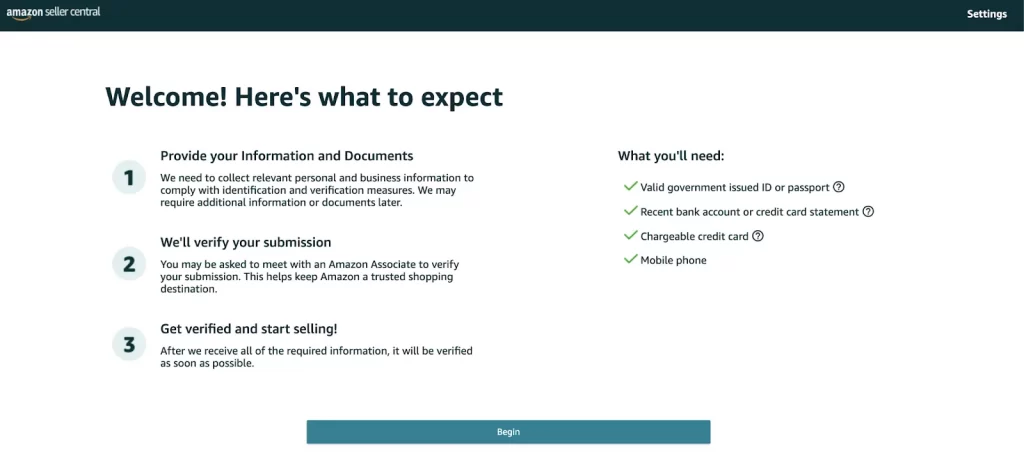
- #4. Provide additional information about your business, such as the types of products you plan to sell and your desired pricing strategy.

- #5. Enter your personal information —either your passport number or your driver’s license and verify your phone number
- #6. Set up your payment method and agree to Amazon’s seller terms and conditions.

- #7. Add product and Amazon store information and click Next button

- #8. Upload images of your ID (license or passport) to verify your identity Add product and Amazon store information and click Next button.
Once your account is set up and approved, you can begin listing your products on Amazon and taking advantage of Amazon’s fulfillment services. For those wondering how to start an Amazon FBA business, this is a key step in getting your products in front of millions of potential customers.
Step 5: Start Amazon listings
After finishing 4 first steps on the journey of answering how to start an Amazon FBA business, you need to create a new Amazon listing to make your product visible and accessible. Here’s how to list your products on Amazon in 2 cases:
Listing a new product:
- #1. Start listing on Amazon: In your Seller Central account, go to Catalog > Add products > I’m adding a product not sold on Amazon.
- #2. Classify your Amazon product: Choose the category that best fits your product.
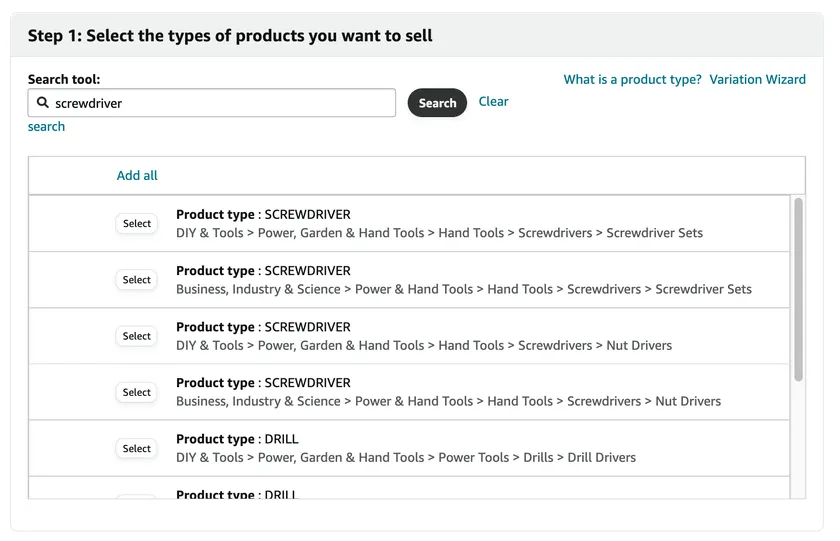
- #3. Enter product details: Fill in the required information including product ID (GTIN), title, description, images, pricing, and fulfillment method (FBM or FBA).
Listing an existing product:
- #1. Find the ASIN of the item: You can find the ASIN number on the URL of the existing listing page or use 2 other methods on how to get ASIN number from Amazon in our detailed guide
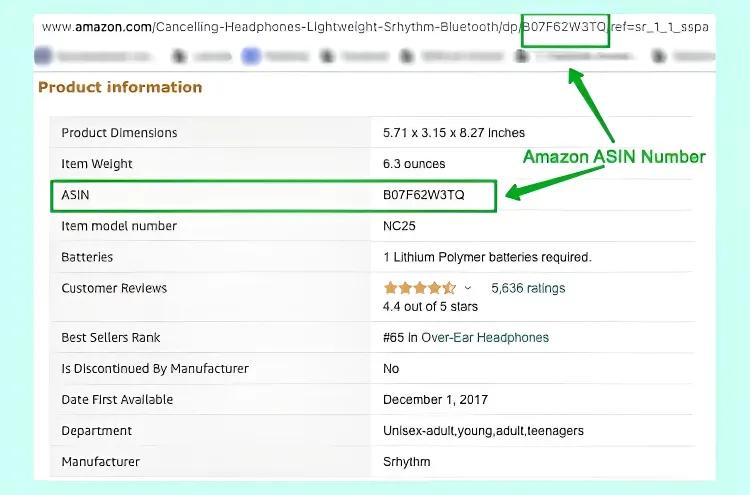
- #2. Search for your product: In your Seller Central account, go to “Catalog” > “Add products” and search for the ASIN you obtained.
- #3. Click “Sell this product”: Choose your product’s condition and click “Sell this product” to continue.
- #4. Fill in the product details: Enter your price, item condition, and fulfillment method. Then click “Save and finish”

- Listing items via a Listing App:
- #1. Integrate with central store: You need to integrate your central store (Shopify, Wix, etc.) with Amazon in 3 basic ways or check out some popular product type listing errors here
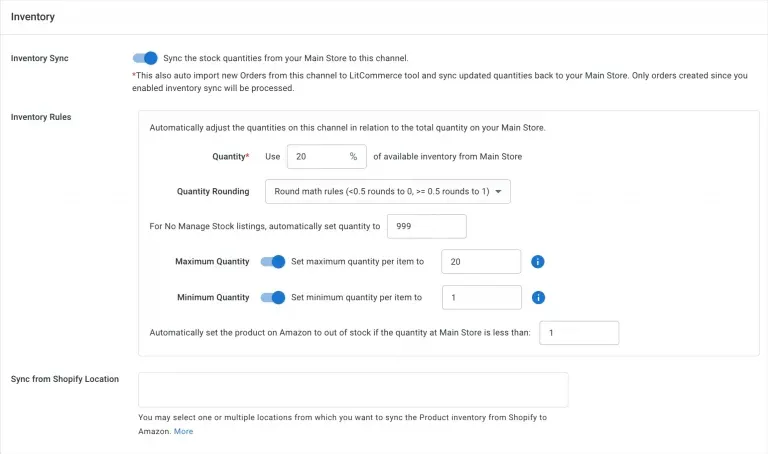
- #2. Select and list the product: Choose the products you want to list on Amazon and choose “List Products to Channels”: Once you’ve linked your central store and Amazon through LitCommerce, your product listings will be automatically imported to the central dashboard.
- #3. Edit your draft listing: Click “Add as Draft Now” for the chosen products and edit your draft listings on Amazon before publishing them.
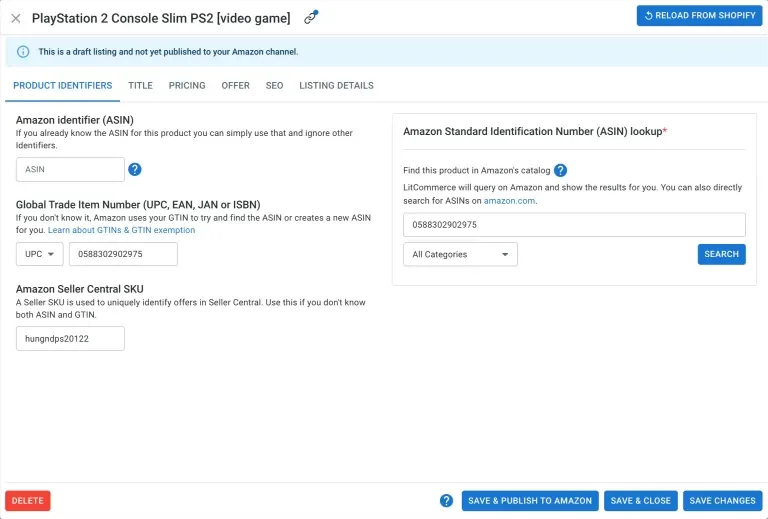
- #4. Publish products: Click “Save and Publish to Amazon” to make your listing live.
List on Amazon with LitCommerce
List on Amazon easily with LitCommerce, using our powerful listing tool, multi-edit mode, listing templates, recipes, and SEO support!
Step 6: Register with fulfillment by Amazon-FBA
Shipping products independently can be both time-consuming and costly. Managing distribution and providing exemplary customer service on your own can be intimidating. The best way to address this is to register for Amazon FBA, allowing Amazon to handle your shipping and customer service needs.
To get started, visit the “Fulfillment by Amazon” page in your seller account. From there, you can select the products you want Amazon to fulfill and provide necessary details such as dimensions and weight.
You can review FBA costs and get an estimate for each product you want to enroll in the program.
If you’re searching for the best way to ship products to Amazon FBA, this guide outlines the two most popular FBA shipping methods.
Step 7: Set up shipping plans and tracking inventory
The next step to address how to start an Amazon FBA business is to set up shipping plans and tracking inventory. You can follow these steps:
- #1. Create a shipping plan: In your Amazon seller account, go to Manage Inventory and select the products you want to include in your shipment. Click on Send/Replenish Inventory and follow the prompts to create a new shipping plan. Enter the shipment mode, carrier information, shipping address, and delivery date.
- #2. Prepare your products for shipping: Once you’ve created your shipping plan, prepare your products for shipment according to Amazon’s guidelines. This may include labeling your products, packaging them appropriately, and ensuring they’re ready for transportation.
- #3. Ship your products to Amazon: Once your products are ready for shipment, print your shipment ID labels and shipping labels from your Amazon seller account. Attach them to your products and ship them to the designated Amazon fulfillment center.
- #4. Monitor your shipments: You can track the progress of your shipment by going to the Shipping Queue in your Amazon seller account. Here, you can see the status of your shipment, including the number of units received, and any errors or issues that need to be resolved.
- #5. Manage your inventory: You can monitor and manage your inventory in your Amazon seller account. From the Inventory tab, you can see the status of each product, check the number of units available, and update your listings as needed.
Overall, setting up shipping plans and tracking inventory helps sellers understand how to start an Amazon FBA business, ensuring smooth operations and maximizing sales.
Wanna sell on Amazon without inventory? Check this How to Sell on Amazon Without Inventory?
Step 8: Optimize product listing
Next, it is advocating that you build a marketing and promotion plan to start an Amazon FBA business. Consider the following approaches:
Conduct keyword research
Along with compelling product listings, keyword research is an integral part of optimizing Amazon listings for how to start an Amazon FBA business. Hence, we suggest some great ways for you to conduct keyword research more easily and effectively:
- #1. Put yourself in the customer’s shoes: Identify your ideal customers’ search keywords and phrases they use when searching for products similar to yours.
- #2. Utilize keyword research tools: It is in your best interest to leverage tools such as Amazon’s keyword research tool or third-party tools like MerchantWords, Helium 10, or Jungle Scout to discover relevant keywords with high search volumes and low competition.
Create compelling product listings
For compelling product listings for your “How to start an Amazon business?” journey, you can refer to the following strategies:
- #1. Craft an engaging product title: You should develop a concise, keyword-rich title that accurately describes your product and its unique selling points.
- #2. Write persuasive product descriptions: You are encouraged to highlight the key features, benefits, and any special promotions or discounts your product offers. It is suggested to use persuasive language and compelling storytelling techniques to capture the interest of potential buyers.
- #3. Emphasize unique selling propositions (USPs): It’s highly recommended that you differentiate your product from competitors by highlighting its unique features, superior quality, or any exclusive offers. Besides, it is suggested to communicate why customers should choose your product over others.
- #4. Utilize bullet points and formatting: You ought to organize information using bullet points, headings, and bold text. Using them helps customers scan and understand the key details about your product more easily.
If you need a more detailed guide on listing products on Amazon. We have this ultimate listing tutorial for newbies!
Focus on high-quality product images
For how to start an Amazon FBA business more effectively, you should not ignore the visual aspect. Here are some tips for high-quality product images that you can refer to:
- #1. Use professional product photography: Invest in high-quality product images that showcase your product from multiple angles and provide a clear representation of its features, texture, and color.
- #2. Highlight key product details: Ensure your images display important features, such as size, dimensions, and any unique attributes. Moreover, don’t forget to consider using close-ups and lifestyle images to demonstrate how the product can be used.
- #3. Optimize image resolution and formatting: Follow Amazon’s guidelines for image size and resolution to ensure your images appear sharp and visually appealing across different devices.
- #4. Incorporate infographics or comparison charts: Supplement your product images with infographics or comparison charts that succinctly highlight your product’s advantages over competitors, such as specifications, performance, or durability.
List on Amazon with LitCommerce
List on Amazon easily with LitCommerce, using our powerful listing tool, multi-edit mode, listing templates, recipes, and SEO support!
Step 9: Build a promotion plan
For the question “how to start an Amazon FBA business” the above steps are general, and the process may vary depending on your specific goals and campaign strategy. Conducting research and consulting with Amazon advertising experts is crucial in helping develop an effective Amazon PPC campaign strategy for your FBA business.
Social media and influencer marketing
To deploy social media and influencer marketing to develop how to start an Amazon business, you can follow these steps:
- #1. Develop a social media strategy: It would be wise to decide which social media platforms to focus on based on your target audience. You should create a content calendar that outlines when and what type of content to post.
- #2. Leverage influencer marketing: You should find influencers in your niche who have a significant following on social media and whose audience aligns with yours. You can collaborate with influencers to promote your products on their channels. This can include sponsored posts, product reviews, or affiliate marketing.
- #3. Build a community: You must engage with your followers on social media, respond to comments and messages, and encourage user-generated content. This helps build brand loyalty, generate word-of-mouth marketing, and increase visibility.
- #4. Analyze your performance: You can use social media analytics tools to track your performance and adjust your strategy as needed. Remember to pay attention to engagement rates, click-through rates, and conversions to measure the effectiveness of your social media and influencer marketing efforts.
Email marketing
Besides social media and influencer marketing, email marketing constitutes a paramount channel that holds significant importance in effectively addressing the query of how to start an Amazon FBA business. To deploy email marketing power, you can follow these steps:
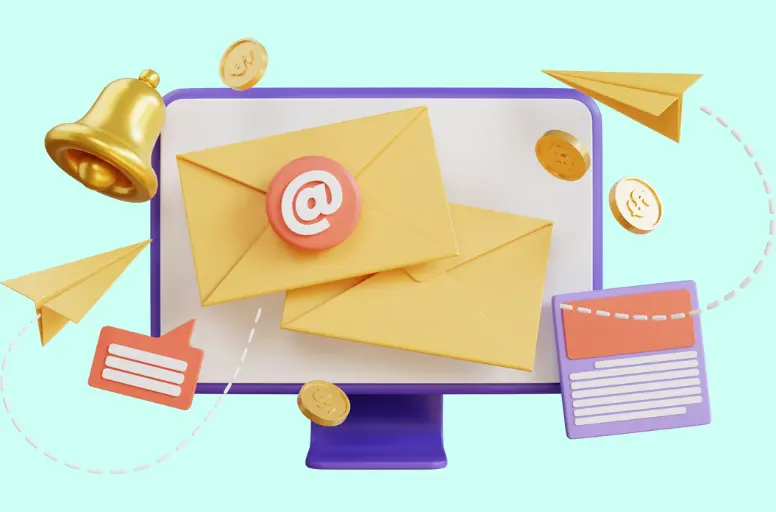
- #1. Collect email addresses: You can collect the email addresses of your customers through Amazon’s buyer-seller messaging service or by offering incentives like discounts or freebies in exchange for email sign-ups.
- #2. Use an email marketing tool: You should use a reliable email marketing tool designed specifically for Amazon sellers, such as FeedbackWhiz, SageMailer, or JungleMail. These tools help automate email campaigns and provide valuable analytics to track performance.
- #3. Determine your email goals: You ought to set clear goals for your email campaigns. In detail, you might want to list if your goals are increasing sales, boosting product reviews, or promoting seasonal discounts.
- #4. Develop engaging content: You can create engaging and relevant content for your emails. This includes personalized product recommendations, exclusive offers, and useful information that your customers will find valuable.
- #5. Segment your email list: Segment your email list based on the demographics, purchasing behavior, and interests of your customers. This helps tailor your message and increase the chances of conversion.
- #5. Test and optimize your campaign: Don’t forget to test and optimize your email campaigns regularly based on performance data. Experiment with different subject lines, call-to-actions, and launch schedules to determine what works best for your audience.
How Much Does It Cost to Start an Amazon FBA Business?
FBA costs depend on the products you sell and the services you decide to use. FBA uses a pay-as-you-go model, with storage and fulfillment costs charged per unit and order. For the question “How much to start an Amazon FBA business”, let’s look at the cost structure of Amazon:
Costs breakdown structure
- Fulfillment cost: Covers picking and packing your orders, shipping and handling, customer service, and returns. It’s based on product type, size, and shipping weight or dimensional weight.
- Monthly storage costs: Based on product size, volume, average number of daily units stored, dangerous goods status, and the month of the year.
- Aged inventory: Charged monthly for all items stored in a fulfillment center for more than 181 days. Pro tip: maintaining sound inventory health can help you avoid this cost.
- Other cost: return processing, removal disposal, liquidation orders, FBA inbound placement service.
FBA Revenue Calculator
Understanding your costs and how they impact your profit is important in determining your fulfillment method.
The FBA Revenue Calculator is a helpful tool that can remove some of the guesswork. Use the calculator to quickly compare estimated costs and profits for FBA and your fulfillment method to determine if FBA is right for you.
3+ Tips to Start an Amazon FBA Business
Starting an Amazon FBA business can be an exciting and profitable venture with the right preparation and execution. Here are some comprehensive tips that can help you start your business smoothly and clearly for the question of how to start an Amazon FBA business:
1. Choose a profitable niche
Selecting a profitable niche is crucial for standing out in a competitive market. Focus on a product category that you believe is underserved and has high demand. This strategy can help you carve out a unique space in the market. When choosing a niche, consider your interests and expertise, market needs, customer pain points, and competitor analysis to ensure you make an informed decision. Choosing the right niche allows you to target a specific audience effectively and reduces competition, increasing your chances of success.
2. Register for a professional seller account
Signing up for an Amazon Professional Seller account provides access to more features and tools that can help you manage your business efficiently. The Amazon Seller app can be a handy tool for managing your business on the go from your phone or tablet. Benefits of a professional account include the ability to sell in more categories, access to advanced reporting tools, eligibility for top placement on product detail pages, and participation in promotions, all of which can significantly enhance your selling capabilities. A professional account offers enhanced functionality and support, facilitating smoother business operations.
3. Provide outstanding customer service
Providing outstanding customer service can differentiate your business from competitors and build customer loyalty. Make sure to respond to customer inquiries promptly, address issues and complaints effectively, send follow-up emails to ensure customer satisfaction, offer discounts or promotions, and encourage positive reviews by providing a great shopping experience. Excellent customer service can lead to repeat business and positive word-of-mouth referrals. Superior customer service enhances your brand reputation and fosters long-term customer relationships.
4. Stay compliant with Amazon’s policies
Ensuring compliance with Amazon’s policies is essential to maintaining a good standing on the platform. Understand and adhere to their terms of service, prohibited product categories, and performance metrics. Staying compliant helps avoid account suspensions and ensures that your business operates smoothly within Amazon’s ecosystem, protecting your reputation and revenue stream. Compliance with Amazon’s guidelines helps you avoid penalties and maintain a positive seller status.
How to Start an Amazon FBA Business – FAQs
The initial costs involved in starting an Amazon FBA business include FBA fees, digital assets like product photos, software tools, inventory costs, shipping costs, graphics and logo costs, and product costs. It’s important to note that these costs may vary depending on the type of products you plan to sell and how much inventory you want to purchase upfront. Some sellers suggest that, on average, around $3,836 is needed to get an FBA business off the ground, but the actual cost may vary widely. You should review the fees and pricing associated with selling on Amazon and create a detailed budget plan before starting your FBA business. It can take anywhere from a few days to several weeks or even a few months to start making sales on Amazon, depending on various factors such as the product, pricing, competition, marketing, and fulfillment method (FBA or non-FBA). Some sellers may get their first sale within a few days or weeks of listing their products, while others may take longer. However, according to one of the search results, if you are consistent, you can quickly launch your first product within 3 months, just like 55% of other Amazon sellers have done. Yes, it is possible to sell internationally through Amazon FBA. With Amazon Global Selling and FBA Export, sellers can offer export-eligible inventory to international customers at no extra cost to them. Additionally, with FBA Pan-EU, sellers can sell to customers in Europe at local prices and can have their products stored and fulfilled across the various Amazon fulfillment centers in Europe, making it easier for customers to receive their orders quickly and for sellers to manage their inventory. Amazon FBA (Fulfillment by Amazon) can be profitable, but success requires diligence and depends on various factors. While some people claim that it’s possible to make millions, this outcome isn’t guaranteed for everyone. According to TrueProfit, 64% of Amazon sellers become profitable within 12 months, and 40% of sellers earn between $1,000 and $25,000 per month. The initial investment to start an Amazon FBA (Fulfillment by Amazon) business in the USA can vary widely, but a common estimate ranges from $2,000 to $5,000 USD. This estimate covers expenses such as product sourcing, Amazon fees, initial inventory, and marketing costs. Amazon FBA sellers are responsible for the shipping costs to Amazon warehouses, which include freight, duty, and insurance. On average, sellers pay approximately $0.25 to $0.30 per pound to ship their products.
How to Start Selling on Amazon – Conclusion!
In conclusion, starting Amazon FBA businesses can be an exciting and profitable venture with the right preparation and execution. By following the steps in this article, sellers can answer the question of how to start an Amazon FBA business step-by-step easily and lay a strong foundation for their FBA business. It is important to keep learning and adapting to the ever-evolving landscape of Amazon, one of the best-selling platforms in the world, to stay competitive and expand the reach of the business.
The initial costs and the timeline to see results may vary based on several factors, but by following a well-thought-out plan and putting in the hard work, anyone can learn how to start an Amazon FBA business and achieve success.
Lastly, we invite you to read our retailer’s blog, which boasts over 10,000 members worldwide, to gain access to valuable eCommerce insights, tips, and strategies




